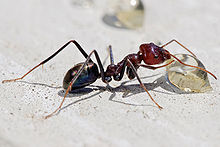| Revision as of 15:17, 5 September 2021 editZacmh (talk | contribs)Autopatrolled, Extended confirmed users3,666 editsm →Tribes and generaTag: Visual edit← Previous edit | Revision as of 21:19, 28 March 2022 edit undoPlantdrew (talk | contribs)Autopatrolled, Extended confirmed users, New page reviewers645,587 edits dab termNext edit → | ||
| Line 38: | Line 38: | ||
| **'']'' <small>], 1936</small> | **'']'' <small>], 1936</small> | ||
| **'']'' <small>], 1947</small> | **'']'' <small>], 1947</small> | ||
| **'']'' <small>], 1878</small> | **'']'' <small>], 1878</small> | ||
| **†'']'' <small>McKellar, Glasier & Engel, 2013</small> | **†'']'' <small>McKellar, Glasier & Engel, 2013</small> | ||
| **'']'' <small>], 1907</small> | **'']'' <small>], 1907</small> | ||
| Line 50: | Line 50: | ||
| **'']'' <small>Dubovikov, 2004</small> | **'']'' <small>Dubovikov, 2004</small> | ||
| **'']'' <small>Shattuck, 1992</small> | **'']'' <small>Shattuck, 1992</small> | ||
| **'']'' <small>Shattuck, 1992</small> | **'']'' <small>Shattuck, 1992</small> | ||
| **'']'' <small>Shattuck, 1992</small> | **'']'' <small>Shattuck, 1992</small> | ||
| **'']'' <small>], 1895</small> | **'']'' <small>], 1895</small> | ||
Revision as of 21:19, 28 March 2022
Subfamily of ants
| Dolichoderinae | |
|---|---|

| |
| Iridomyrmex purpureus feeding on honey | |
| Scientific classification | |
| Domain: | Eukaryota |
| Kingdom: | Animalia |
| Phylum: | Arthropoda |
| Class: | Insecta |
| Order: | Hymenoptera |
| Family: | Formicidae |
| Subfamily: | Dolichoderinae Forel, 1878 |
| Type genus | |
| Dolichoderus Lund, 1831 | |
| Diversity | |
| 48 genera | |
Dolichoderinae is a subfamily of ants, which includes species such as the Argentine ant (Linepithema humile), the erratic ant, the odorous house ant, and the cone ant. The subfamily presents a great diversity of species throughout the world, distributed in different biogeographic realms, from the Palearctic, Nearctic, Afrotropical region and Malaysia, to the Middle East, Australian, and Neotropical regions.
This subfamily is distinguished by having a single petiole (no post-petiole) and a slit-like orifice, from which chemical compounds are released. Dolichoderine ants do not possess a sting, unlike ants in some other subfamilies, such as Ponerinae and Myrmicinae, instead relying on the chemical defensive compounds produced from the anal gland.
Of the compounds produced by dolichoderine ants, several terpenoids were identified including the previously unknown iridomyrmecin, isoiridomyrmecin, and iridodial. Such compounds are responsible for the smell given off by ants of this subfamily when crushed or disturbed.
Tribes and genera
- Bothriomyrmecini Dubovikov, 2005
- Arnoldius Dubovikov, 2005
- Bothriomyrmex Emery, 1869
- Chronoxenus Santschi, 1919
- Loweriella Shattuck, 1992
- Ravavy Fisher, 2009
- Dolichoderini Forel, 1878
- Dolichoderus Lund, 1831
- Leptomyrmecini Emery, 1913
- Anillidris Santschi, 1936
- Anonychomyrma Donisthorpe, 1947
- Azteca Forel, 1878
- †Chronomyrmex McKellar, Glasier & Engel, 2013
- Doleromyrma Forel, 1907
- Dorymyrmex Mayr, 1866
- Forelius Emery, 1888
- Froggattella Forel, 1902
- Gracilidris Wild & Cuezzo, 2006
- Iridomyrmex Mayr, 1862
- Leptomyrmex Mayr, 1862
- Linepithema Mayr, 1866
- Nebothriomyrmex Dubovikov, 2004
- Ochetellus Shattuck, 1992
- Papyrius Shattuck, 1992
- Philidris Shattuck, 1992
- Turneria Forel, 1895
- †Miomyrmecini Carpenter, 1930
- Tapinomini Emery, 1913
- Aptinoma Fisher, 2009
- Axinidris Weber, 1941
- †Ctenobethylus Brues, 1939
- Ecphorella Forel, 1909
- Liometopum Mayr, 1861
- Tapinoma Förster, 1850
- Technomyrmex Mayr, 1872
- incertae sedis
- †Alloiomma Zhang, 1989
- †Asymphylomyrmex Wheeler, 1915
- †Elaeomyrmex Carpenter, 1930
- †Elaphrodites Zhang, 1989
- †Eldermyrmex Heterick & Shattuck, 2011
- †Emplastus Donisthorpe, 1920
- †Eotapinoma Dlussky, 1988
- †Eurymyrmex Zhang, Sun & Zhang, 1994
- †Kotshkorkia Dlussky, 1981
- †Ktunaxia Lapolla & Greenwalt, 2015
- †Leptomyrmula Emery, 1913
- †Petraeomyrmex Carpenter, 1930
- †Proiridomyrmex Dlussky & Rasnitsyn, 2003
- †Protazteca Carpenter, 1930
- †Usomyrma Dlussky, Radchenko & Dubovikoff, 2014
- †Yantaromyrmex Dlussky & Dubovikoff, 2013
- †Zherichinius Dlussky, 1988

See also
References
- Bolton, B. (2015). "Dolichoderinae". AntCat. Retrieved 4 January 2015.
- Cardoso, D.; Cristiano, M. P.; Barros, L. S.; Lopes, D.; Pompolo, S. (2012). "First cytogenetic characterization of a species of the arboreal ant genus Azteca Forel, 1978 (Dolichoderinae, Formicidae)". Comparative Cytogenetics. 6 (2): 107–14. doi:10.3897/CompCytogen.v6i2.2397. PMC 3833797. PMID 24260655.
{{cite journal}}: CS1 maint: unflagged free DOI (link) - Fisher, Brian L. and Stefan P. Cover (2007) Ants of North America: a guide to the genera
- Wilson, E. O.; Pavan, M. (1959). "Glandular Sources and Specificity of Some Chemical Releasers of Social Behavior in Dolichoderine Ants". Psyche: A Journal of Entomology. 66 (4): 70. doi:10.1155/1959/45675.
 This article incorporates text from a scholarly publication published under a copyright license that allows anyone to reuse, revise, remix and redistribute the materials in any form for any purpose: Cardoso, D.; Cristiano, M. P.; Barros, L. S.; Lopes, D.; Pompolo, S. (2012). "First cytogenetic characterization of a species of the arboreal ant genus Azteca Forel, 1978 (Dolichoderinae, Formicidae)". Comparative Cytogenetics. 6 (2): 107–14. doi:10.3897/CompCytogen.v6i2.2397. PMC 3833797. PMID 24260655.
This article incorporates text from a scholarly publication published under a copyright license that allows anyone to reuse, revise, remix and redistribute the materials in any form for any purpose: Cardoso, D.; Cristiano, M. P.; Barros, L. S.; Lopes, D.; Pompolo, S. (2012). "First cytogenetic characterization of a species of the arboreal ant genus Azteca Forel, 1978 (Dolichoderinae, Formicidae)". Comparative Cytogenetics. 6 (2): 107–14. doi:10.3897/CompCytogen.v6i2.2397. PMC 3833797. PMID 24260655.{{cite journal}}: CS1 maint: unflagged free DOI (link) Please check the source for the exact licensing terms.
External links
 Media related to Dolichoderinae at Wikimedia Commons
Media related to Dolichoderinae at Wikimedia Commons
| Ant taxonomy | |||||
|---|---|---|---|---|---|
| |||||
| Subfamilies |
| ||||
| Genera | |||||
| Taxon identifiers | |
|---|---|
| Dolichoderinae | |